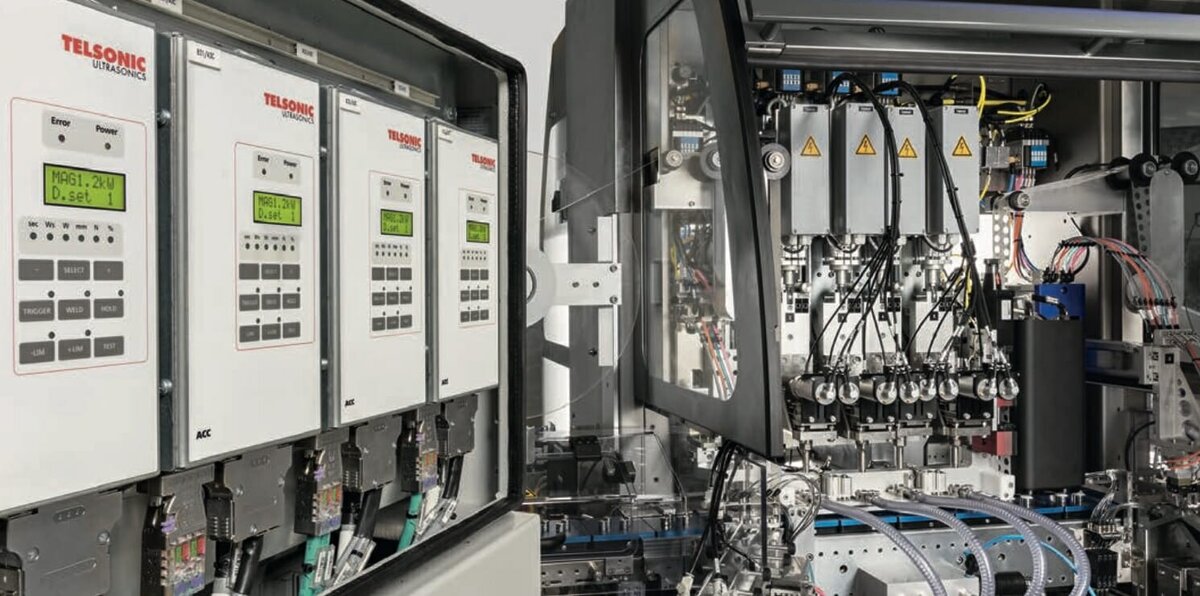The Safe And Economic Joining Solution
Ultrasonic welding is a well proven and reliable method for joining metal or plastic parts. The areas of application for this technology are wide and varied and range from joining thermoplastic components and embedding metal inserts, through to joining wire cables, connecting wire cables to busbars, welding wire cable harnesses and contacts in the automotive and electrical industries, as well as packaging materials and special applications involving enamelled wires, foils and thin metal sheets.
Although using ultrasonic technology as a method for joining metals or plastics may mean higher investment costs initially, when compared to other processes, it is very often more economic in the long term when the tooling costs, energy consumption and joining quality are taken into consideration. In this informative article, Telsonic UK highlight the benefits that the process can bring to many welding and joining applications.
Ultrasonic welding has become established in many application areas because it delivers short and efficient process times and can be easily integrated into automation systems of many different types.
Depending on the area and height of the weld, welding times typically range from 0.2 to 2 seconds. Unlike other joining processes such as thermal welding techniques for joining thermoplastics, no heat-up or cool-down time is required. For metals, different alloys with variable material thickness can be joined together, and the majority of natural oxide layers have very little impact on the weldability of the joints. Aluminium can also be easily welded with ultrasonic technology for example, which is often a challenge for other processes.
In comparison to other metal welding processes, the parts which are being joined do not become as hot, ensuring they never meet their melting point. This results in several advantages compared to other joining techniques: other materials in the immediate vicinity such as wire insulation are not damaged. In addition, no structural changes occur in the boundary layer, such as embrittlement of the parts that are being joined at the transition to the solid material.
Low energy demand and a long service life
Ultrasonic welding is also very energy efficient. The ultrasonic system uses state-of-the-art high-performance electronics to convert the electrical energy into vibration energy and thermal energy in the fusion zone with a high degree of efficiency. This energy can vary between a few joules to several kilojoules. The welding force is usually generated by pneumatic cylinders. Depending on the application and the duty cycle, compressed air may also be required to cool the tools. A typical ultrasonic generator has an output of 3.6 kW, which is significantly less than the output of a resistance welding machine. Resistance welding often also requires expensive water cooling with additional recycling and cleaning costs, or even a new power supply to provide the required power when multiple systems are used.
The tooling costs associated with the ultrasonic process are also straightforward. The acoustic tools, known as sonotrodes, are typically made of aluminium, titanium or hardened tool steel. Aluminium is inexpensive and can be processed quickly and easily. Titanium may be more expensive, but it is extremely wear-resistant. All variants have an impressively long service life. Depending on the application, ultrasonic sonotrodes are capable of withstanding several hundred thousand cycles. Resistance welding tools on the other hand normally have to be changed daily in an automated environment. With plastic welding, the service life of the sonotrode work surface is significantly longer in some cases and can easily reach well over one million cycles with less abrasive materials.
Application-specific design and optimum quality control
Ultrasonic welding is therefore an inexpensive joining method for the majority of thermoplastics and non-ferrous metals such as aluminium, copper, brass and nickel. However, failure to pay attention to having a suitable design for the part in question can result in extensive adaptations and loss of the financial benefits.
Telsonic therefore recommends involving an ultrasonic specialist at an early stage of the design phase, in order to ensure that the design of the component and the joining zone is compatible with the ultrasonic process, avoiding the need for modifications and additional costs at a later date. Ultrasonic welding is therefore always worth considering, because the cost of the ultrasonic welding system can often be justified by the substituting of another process such as a tinning station in the case of metals, or by eliminating the need for fastening items such as holders or clips etc. An ultrasonic welding system can also reduce labour costs and eliminate the risk of injury associated with crimping and soldering processes.
The various quality control options, which are often overlooked, also contribute to reducing costs. Feedback is provided for each part regarding quality-relevant variables such as total energy, maximum output, welding time, absolute or differential part thickness, etc. The intelligent process control unit that is used by the system can detect problems based on defined tolerance ranges, such as missing or incompletely formed contours, the use of an incorrect number of wires, missing strands, changes to material hardness and thickness or even the complete absence of parts in the tool. This makes a significant contribution to preventing bad parts from entering the production chain, and reduces reworking time, waste and expenditure.
Environmentally friendly and easy to use
Since ultrasonic welding systems do not require water cooling, and also have low air consumption requirements, operating costs are reduced. Air or fume extraction is not usually required, since the majority of plastic and metal applications do not produce vapours or gases. In addition, ultrasonic metal welding does not require any other consumables such as crimp sleeves, flux or solder. When ultrasonics are used to join plastics, additional components such as seals, adhesives and solvents are not required. Nor is it generally necessary to clean the parts which are being joined, since the ultrasonic vibration which is generated removes contamination and breaks up, in the case of metals, the oxide layers.
The majority of ultrasonic welding systems are relatively simple to use. A one-day training course is usually sufficient. Modern welding process control systems are menu-driven and therefore extremely user-friendly. The process parameters for the various welding combinations and projects are saved and can be easily retrieved, which practically eliminates the risk of any operating errors caused by incorrect machine settings.
Ultrasonic joining technology for plastics and metals is therefore safe, economic and ecological. It is now widespread in the automotive industry, since it actively supports weight reduction, energy efficiency and electromobility. It is suitable for virtually any lightweight material and is also used for the on-board power supplies of high-current applications in electric vehicles, where copper is increasingly being replaced by aluminium to save weight. Short cycle times, selective energy supply, flexibility in use and a high degree of process reliability are other criteria that characterise ultrasonic welding technology.
Telsonic UK offer a comprehensive range of ultrasonic modules and systems for a variety of plastic and metal welding, cutting, sealing, cut’n’seal, food cutting, sieving and cleaning applications within a wide range of industries.








